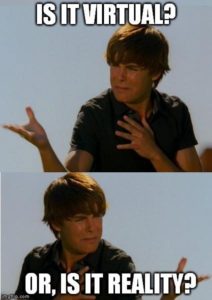Government is keeping tighter budgets.
+
Boundaries whether real or political are disappearing.
+
The internet is growing.
=
A future of simulated environments for direct services.

As the need for services will continue to grow and there is less money to do it, government agencies will begin to turn to virtual realities to provide direct services. Customers want to feel as if they are in somewhere “official” and talking to a professional to receive their services. But real estate is expensive and a decentralized workforce helps keep costs down.
These trends have already begun within the medical field to provide services to those in more rural and isolated areas. A preliminary version of this can be seen with the United States Veterans Administration (U.S. VA) with their telehealth initiative.
Just think: all spaces become accessible, there is no need for expensive transportation to isolated areas, the rural and urban populations could access the same benefits, elderly would be able to obtain care without potentially dangerous travel. And it can all be done in virtual settings that make us feel transported without ever leaving our homes or communities.
The most basic form of this is already being done within the real estate realm using Google Maps like the example of an office space below. Using this type of technology to “create” professional environments where clients can meet with government professionals, deal with paperwork and other administrative issues with a real person all from the comfort of their homes.
With older adults quickly set to outpace the number of children by 2030, the government will need to make adjustments to how it provides services to meet the increasing limited mobility and isolation often associated with older adults.
Virtual reality has already been shown to have positive effects on those with limited mobility and those unable to socialize due to mobility issues. This means addressing the concerns of those with disability and even those with social anxieties.
Government’s job is to remove as many barriers as possible to provide services to the largest amount of constituents possible. Virtual reality could quite possibly be one tool that allows the government to expand its reach and serve more people.
While it should not be the exclusive tool to increase access, government agencies would be wise to begin investing in creating a virtually friendly environment so that when the transition to virtual reality comes, these agencies are prepared to assist and use this technology to their advantage.